For BJT's there is a PN junction between the base and emitter. The arrow indicates the order of the junction (base to emitter or emitter to base). An NPN has stacked N, P, and N doped channels. The PN junction (between base and emitter) goes from the center out. PNP likewise is the opposite.
Observations, not necessarily fact:
In a MOSFET, the body is often connected to the source. For an N-channel MOSFET, the source is N-doped and the body is P-doped, so the arrow points from the source to the body. Likewise, a P-channel MOSFET has the reverse condition. Interestingly, Wikipedia has symbols for "MOSFETS with no bulk/body" which have opposite arrow directions. I have no good explanation for why these are this way, though I suspect it might follow a similar pattern and the semiconductor topology is different from "traditional" MOSFET topologies.
Your symbols for b (FET) are JFET symbols. Here, the PN junction is between the gate and "body" (semiconductor section connecting the drain and source; I don't know what the correct for this part of a JFET is so I just called it the body because it takes the bulk volume of the JFET). For an N-channel, the gate is P-doped and the body is N-doped, so the arrow points from the gate in. The P-channel JFET is the opposite so the arrow points out of the gate.
I've never used unijunction transistors (case d), but looking at the wikipedia page shows a similar doping structure as the JFET, the only difference the lack of an insulated gate (names also have changed, apparently it follows the "BJT" type naming of base and emitter). I would not be surprised if the arrow direction convention follows the order of the PN junction (wasn't immediately obvious to me which type the example structure on Wikipedia was for).
Additional info:
Bipolar Junction Transistors
MOSFET
JFET
unijunction transistors
